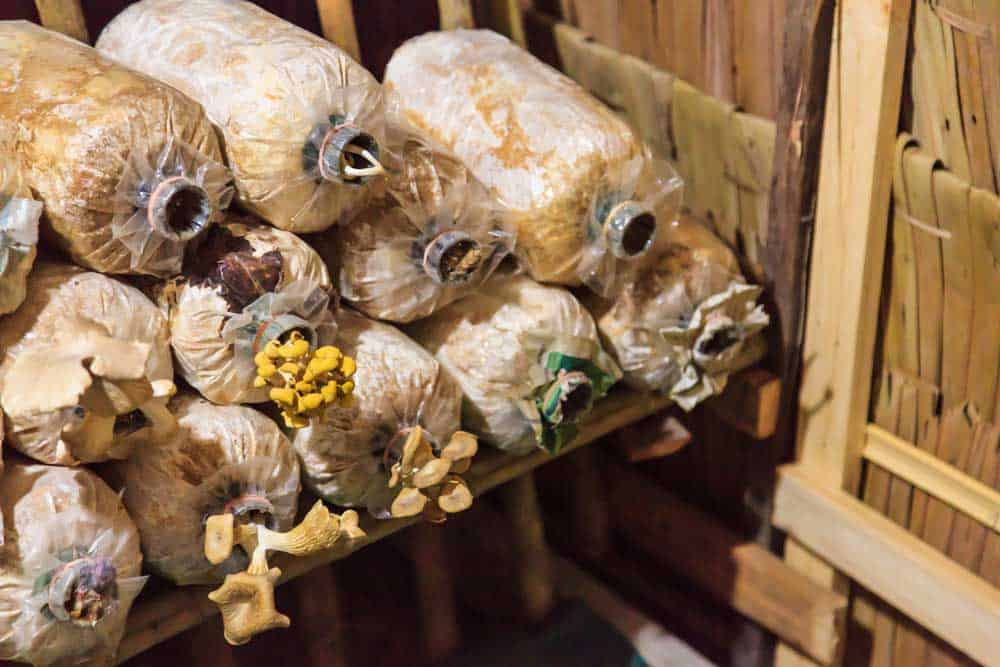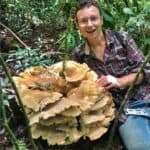Table of Contents
Mushroom spawn is essentially a mycelium “seed” used for mushroom production. It is with spawn that mushroom growers inoculate their bulk growth substrate. After inoculating a substrate with spawn, its mycelium colonizes the substrate. After colonization, the fungus produces the prized mushroom fruiting bodies. You can also spread spawn onto agar, liquid culture, or a solid substrate for making more spawn.
Mushroom Spawn is for spreading Mycelium
Mycelium is the white filamentous part of mushroom-forming fungi. It’s a web-like network of small white threads often seen on the forest floor. Mycelium is the body of the fungi, whereas mushrooms are the reproductive structures.
Mycelium can be easily cloned. Any cell can form a new and independent colony. This is how spawn works. You take your colonized spawn, break it up, and use it to inoculate a new substrate. You only need about 5% spawn to fully colonize a substrate. This means 1 kg of spawn can inoculate 20 kg of growth substrate!
Inoculation is the act of introducing a fungal culture into a new growth medium. The word “inoculum” refers to the source of the culture used during inoculation. Other examples of inoculums are agar, liquid cultures, or even tissues of a mushroom.
Mushroom Spawn should be clean!
Mushroom spawn has to be completely clean and free of contaminants. If spawn has contamination, you will be off to a bad start. Since spawn is often grown on nutrient-rich substrates, it is prone to contamination.
For this reason, spawn production takes place under highly controlled conditions. This means complete sterilization and good sterile technique. Most spawn production occurs in laboratory-like conditions using a laminar flow hood. Even still, it is possible to produce spawn at home with the right technique. Some varieties like Oyster Mushrooms are easier to work with.
How to know you have clean, High-Quality Spawn?
- It is completely white and colonized by mycelium
- No odd colors or discoloration
- No parts of the spawn lack colonization
- Your spawn may be too old if it is difficult to break apart or has started to pin
Types of Mushroom Spawn
Mushroom spawn is most often grown of different types of grain, but it can be grown on other types of material. It is most often grown within jars or mushroom grow bags.
Mason Jars vs Grow Bags for Mushroom Spawn
Mason Jars and Grow Bags are the two most common growth vessels for the mushroom spawn. They each have their pros/cons depending on your goals and preferences.
Mason Jars are great for spawn for the following reasons:
- You can find them almost anywhere
- They are 100% reusable
- They come in various sizes
- Jar lids are easily modified for spawn production
There are some downsides to mason jars. Mostly it’s that they don’t work well with anything bigger than quart-size jars. They only breathe through the top, so proper air exchange is hard to achieve with larger jars. The other downside is they need cleaning, so this can become laborious.
Grow Bags have benefits as well, including;
- They are prefabricated and need no modifications
- You can grow larger quantities of spawn
- Inexpensive for commercial spawn production
- Don’t require cleaning
The bad thing about grow bags is that they create plastic waste. They are also not easily accessible to people in remote areas.
Growth Mediums for Spawn
What makes a good growth Medium for Mushroom Spawn?
- The material should be nutritious and allow for vigorous mushroom growth. This will allow mycelium to spread aggressively after inoculation.
- The material should be easy to spread and disperse. This usually means a material composed of small and homogenous pieces. Smaller material will have more “inoculation points” from which the mycelium can spread.
Mushroom Grain Spawn
This is the most conventional and common form of mushroom spawn. Grain works as a perfect medium for spawn for several reasons. It has a high nutrient content, is small in size, and easily accessible.
Types of Grain Spawn
- Rye Grain: This is the most common and recommended type of grain spawn. Most mushrooms love it, and it’s less delicate than other grains.
- Wheat Berries: Wheat berries are a bit easier to get and also work great. It’s important to properly process wheat berries because they are easier to overcook. This results in a less favorable mushy texture. It is also difficult to spread and prone to contamination.
- Barley: Barley can work as a grain spawn, but is less favored than other grains.
- Sorghum: Sorghum works great as grain spawn. It is often used by commercial spawn producers. Animal-grade sorghum can be one of your most inexpensive options for the spawn.
- Popcorn: Popcorn works for making grain spawn and is easily accessible. You may already have some in your cupboard! While it works well, there are a couple of downsides. It’s more expensive, colonizes slower, and results in fewer inoculation points.
Sawdust Spawn
Sawdust spawn is pretty common, but usually less effective than grain spawn. If you plan to make sawdust spawn, make sure you get 100% pure hardwood sawdust.
- Cheap and accessible
- Doesn’t attract rodents, birds, and other critters
- Works great for logs and other outdoor inoculations
- Also works well for transferring to hardwood fruiting substrates
- Less prone to contamination
Pros and Cons of Sawdust Spawn
Pros
- Cheap and accessible
- Doesn’t attract rodents, birds, and other critters
- Works great for logs and other outdoor inoculations
- Also works well for transferring to hardwood fruiting substrates
- Less prone to contamination
Cons
- Spawn takes longer to colonize
- Not effective for inoculating straw, agricultural waste, and other non-wood substrates
- Substrates inoculated with sawdust spawn colonize slower
- May result in smaller yields
- It may be difficult to get pure hardwood sawdust
Other Growth Mediums used for Spawn
- Wild Bird Seed – Works well, but is expensive. Also, birdseed is unregulated, so its cleanliness is questionable.
- Coffee – Not recommended because it has high rates of contamination. It also does not provide a balanced nutrient source.
- Rice – Rice can work as a medium for grain spawn, but it is less recommended. If you are using rice, make sure to use brown rice, as white rice becomes mushy!
How is Spawn made?
You can make mushroom spawn in different ways. The basic process involves introducing a living culture into a sterilized growth medium. The source of the mushroom culture, the growth medium, and the growth vessel can vary. There are three main ways to make spawn.
1. Making Spawn from Agar
This technique requires sterile conditions as it is prone to contamination. In this case, you introduce a small piece of colonized agar into a sterilized substrate. Since the quantity of inoculum is small, this is a slow process.
2. Making Spawn from liquid Culture
Spawn is also made with liquid cultures. Liquid cultures are mycelium grown on a liquid medium. You transfer liquid cultures via syringe through a self-sealing injection port. This may be the most effective way to make spawn without laboratory conditions.
3. Making Spawn from Spawn
When using grain, this is called a “Grain To Grain Transfer”. Spawn for vigorous mushrooms like oysters don’t require a laminar flow hood. You will still need to practice proper technique and cleanliness. More sensitive varieties will need a flow hood and good technique.
How do I inoculate with Spawn?
Inoculation using spawn varies in difficulty depending on your mushroom variety. In general, hardy mushroom species like oysters can be easily grown from spawn. This is especially true on non-supplemented substrates. Highly nutritious substrates will be more prone to contamination. Lions Mane, Shiitake, and other less resistant species require more precautions.
Inoculating with Spawn the easy way
This method works great for growing oysters on straw or non-supplemented sawdust. You don’t need a laboratory or fancy equipment.
- Pasteurize your substrate either at high temperatures or in an alkaline lime bath.
- Drain your substrate of any excessive moisture for 4-5 hours.
- Take your growth vessel and begin making layers of substrate and spawn. Just like a cake! You only need about 5-10% spawn.
Inoculating with Spawn for more finicky Mushrooms and Substrates
Sometimes you can’t do it the easy way. This is usually because you’re using supplemented substrates, or it’s a finicky mushroom. Supplemented substrates result in larger yields, but have greater risks of contamination. This is why you have to be more careful with nutrient-rich substrates.
Finicky grows need sterilization of the substrate. This means pressure-cooking your substrate at 15 PSI for 1-2 hours! It also means using a sterile technique and either a laminar flow hood or a still air box.
- Laminar Flow Hoods: These are devices that emit a continuous flow of clean filtered air. Inoculations and sterile work done in front of a flow hood are less prone to contamination. Laminar flow hoods are expensive but highly effective.
- Still Air Box: This is a cheap way of reducing contamination. It’s similar to a glove box, but more practical. It’s a closed container whose only openings are for your hands to have access to the inside. You do all your work inside this still air box, where you have tried to create a sterile environment. They are less practical and effective than a laminar flow hood, but much cheaper to make.

